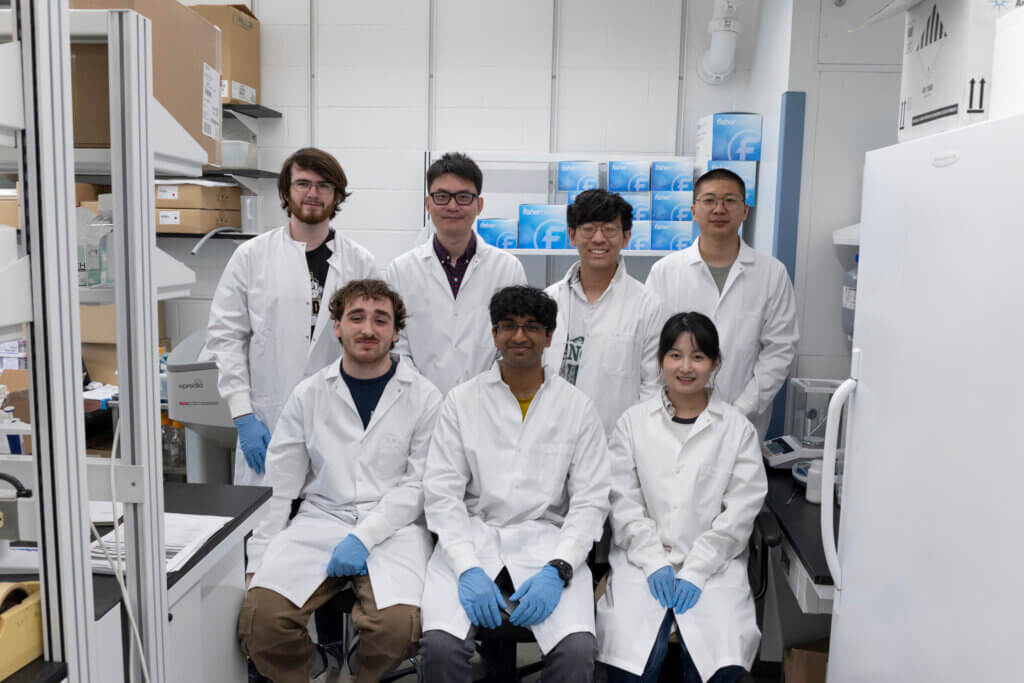Purdue Veterinary Medicine scientist seeks new understanding and targets for treatment
In the battle against Alzheimer’s disease (AD), a progressive neurodegenerative condition that affects millions worldwide, new research could lead to a deeper understanding of its mechanisms and the development of more effective treatments.
Dr. Ranjie Xu, a Purdue assistant professor in the College of Veterinary Medicine’s Department of Basic Medical Sciences and a member of the Purdue Institute for Integrative Neuroscience, is undertaking transformative research into Alzheimer’s disease and related dementias.
Through innovative studies involving human stem cell models, he’s seeking to replicate human Alzheimer’s disease pathology, providing critical insights into disease progression and potential therapeutic targets.
A growing global crisis
Dr. Xu’s interest in Alzheimer’s disease is both personal and professional.
As a grandson, Dr. Xu knows first-hand the toll that Alzheimer’s takes on individuals and their families. His grandfather had the disease and eventually succumbed to it.
As a scientist, Dr. Xu is motivated by the statistics. Dementia – an umbrella term that includes Alzheimer’s and other disorders – is a global health crisis, with more than 55 million people currently living with the condition.
Along with the devastating effects on families, the economic impact of dementia is staggering. According to Alzheimer’s Disease International, the annual global cost of dementia now exceeds $1.3 trillion and is projected to rise to $2.8 trillion by 2030. “That’s a significant burden to the patient, the family member and the society,” says Dr. Xu.
The search for deeper understanding and new treatments
Alzheimer’s is a disease of aging, with the majority of people developing the condition at 65 or older, according to the National Institutes of Health.
Around one in 13 people between ages 65 and 84 develop AD, but that risk factor increases to one in three people aged 85 and older.
Despite the disease’s prevalence, effective treatments remain elusive. As the number of cases worldwide rises, so does the urgency for new therapies.
One of the major hurdles in Alzheimer’s research is the limitations of animal models to accurately reflect human disease. That’s especially true when it comes to studying the role that tau proteins play in disease development.
Tau proteins are mainly found in neurons (nerve cells). They help neurons maintain their shape, function properly and survive.
In Alzheimer’s disease, tau proteins malfunction, forming tangles in the brain, which leads to neuron death and reduced connections between neurons.
The spread of abnormal tau throughout the brain is considered a key factor in the progression of Alzheimer’s disease. Exactly how that happens is unknown, and current animal models don’t fully replicate the complexity of the disease in humans. Dr. Xu aims to change that.
In 2024, Dr. Xu and his team received their first two National Institutes of Health grants. The funding supports two major projects: developing a new brain model for Alzheimer’s and then applying that model and other tools to better understand the impact of lead exposure on Alzheimer’s and related dementias.
A better brain model for AD
In the first project, Dr. Xu’s lab is seeking to create a new human-mouse chimeric brain model for studying tau pathology in Alzheimer’s disease. “Chimeric” refers to something correlated to two or more different sources or origins – in this case, humans and mice.
Mice are often used to model human diseases, but they don’t always accurately replicate the human condition because of differences among species. Using the new chimeric brain model, Dr. Xu and his team can better understand how tau proteins spread and damage nerve cells.
The National Institutes of Neurological Disorders and Stroke is funding the project through an R21 grant, which supports new, innovative research projects in their early stages of development. R21 projects often involve a high degree of risk but have the potential to lead to significant breakthroughs or the development of new techniques and methodologies.
By more precisely modeling how tau proteins affect the development and progression of Alzheimer’s, researchers can identify potential therapeutic targets. These key players in the disease can then be the focus of new treatments designed to improve health.
“There are two Alzheimer’s drugs targeting amyloids: donanemab and lecanemab,” Dr. Xu says. “Tau is another target.”
Dr. Xu’s work could also enable the development of biomarkers to diagnose and monitor the disease. Current gold-standard biomarkers like amyloid and tau PET scans and cerebrospinal fluid analysis are expensive, not universally accessible, and, in some cases, invasive, limiting their use for routine screening or frequent monitoring.
Lead exposure and Alzheimer’s disease
Dr. Xu’s lab also is investigating the role of environmental factors in the development of Alzheimer’s disease and related dementias. Team members are investigating how early-life exposure to lead and other environmental toxins can interact with genetic risk factors, accelerating aging and increasing the risk of dementia.
Dr. Xu serves as a multiple PI on the five-year National Institutes of Aging U01 grant, alongside principal investigator Dr. Chongli Yuan, the Charles Davidson Professor of Chemical Engineering in the Purdue College of Engineering. U01 grants are designed to support externally funded researchers who collaborate with NIH staff on the research.
Several genes are associated with the development of Alzheimer’s disease. Epigenetic changes – alterations to human DNA caused by environmental factors – are also to blame.
It’s common knowledge that exposure to lead at a young age or before birth can cause significant health issues in children. Now, researchers are recognizing that even relatively low levels of lead exposure in childhood or in utero may increase the risk of dementia and cognitive decline in later life.
Dr. Xu’s team is using both in vitro human cell models and in vivo chimeric brain models to understand the changes that occur with lead exposure and how these changes contribute to neurodegeneration.
“We will compare these two models side by side,” Dr. Xu says. “It’s an epigenetic analysis to try to understand those processes.”
Pushing the boundaries of research
Dr. Xu considers the NIH funding a significant milestone for his lab, enabling him to push the boundaries of Alzheimer’s research.
“This funding is very important for my career development,” he says. “It’s hard to do a very comprehensive study. The cost is very high.” NIH funding helps to cover the cost of supplies and personnel to run experiments and analyze results.
By developing advanced models, Dr. Xu is hoping to uncover fundamental aspects of the disease, pinpoint new therapeutic targets and biomarkers, and provide novel tools for drug development.
As the world faces an ever-growing Alzheimer’s crisis, Dr. Xu’s work could ultimately pave the way for new treatments, offering much-needed hope to individuals and families grappling with the disease.



